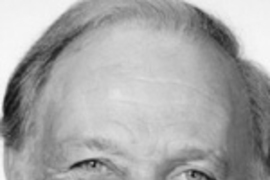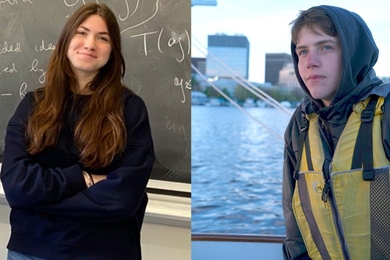MIT Institute Professor Isadore M. Singer shares the 2004 Abel Prize for the discovery and proof of a theorem that is one of the great landmarks of 20th-century mathematics.
The Abel, which has been likened to the Nobel Prize, but for mathematics, was announced by the Norwegian Academy of Science and Letters this morning. The prize was awarded for the first time in 2003.
Singer and Sir Michael Francis Atiyah of the University of Edinburgh will receive the prize from King Harald of Norway on May 25. They will share $875,000 "for their discovery and proof of the index theorem, bringing together topology, geometry and analysis, and their outstanding role in building new bridges between mathematics and theoretical physics," the academy said in its announcement.
The two are also being honored for being instrumental in repairing a rift between the worlds of pure mathematics and theoretical particle physics, initiating a cross-fertilization that has been one of the most exciting developments in recent decades.
"I am delighted to win this prize with Sir Michael," said Singer. "The work we did broke barriers between different branches of mathematics and that's probably its most important aspect. It has also had serious applications in theoretical physics. But most of all I appreciate the attention mathematics will be getting. It's well-deserved because mathematics is so basic to science and engineering.
"I've been at MIT on and off for most of 50 years, and the support MIT has given me has been very special and important in my own research. MIT is an enabling institution that allows people to do ' their thing' very well."
According to Professor David A. Vogan, head of MIT's Department of Mathematics, "Isadore Singer has been the very best kind of intellectual leader, in every way imaginable -- from doing great mathematics himself, to teaching undergraduates, to bringing great mathematicians to MIT.
Vogan describes how when he came to MIT as a graduate student in 1974, "almost the first class that I took was from Isadore Singer. The first lecture was delivered by Atiyah. That lecture was over my head, but close enough to admire."
"After listening to Singer for the rest of the semester, I began to understand a little. Thirty years later I'm still listening, still blown away, but more admiring all the time," said Vogan.
The Index Theorem
Scientists describe the world by measuring quantities and forces that vary over time and space. The rules of nature are often expressed by formulas, called differential equations, involving their rates of change. Such formulas may have an "index," the number of solutions of the formulas minus the number of restrictions that they impose on the values of the quantities being computed. The Atiyah-Singer index theorem calculated this number in terms of the geometry of the surrounding space.
A simple case is illustrated by a famous paradoxical etching of M.C. Escher, "Ascending and Descending," where the people, going uphill all the time, still manage to circle the castle courtyard. The index theorem would have told them this was impossible.
The Atiyah-Singer index theorem was the culmination and crowning achievement of a more than 100-year-old development of ideas, from Stokes's theorem, which students learn in calculus classes, to sophisticated modern theories like Hodge's theory of harmonic integrals.
The problem solved by the Atiyah-Singer theorem is truly ubiquitous. In the 40 years since its discovery, the theorem has had innumerable applications, first within mathematics and then, beginning in the late 1970's, in theoretical physics: gauge theory, monopoles, string theory, and the theory of anomalies, among others.
At first, the applications in physics came as a complete surprise to both the mathematics and physics communities. Now the index theorem has become an integral part of their cultures. Atiyah and Singer, together and individually, have been tireless in their attempts to explain the insights of physicists to mathematicians. At the same time, they brought modern differential geometry and analysis as it applies to quantum field theory to the attention of physicists, and suggested new directions within physics itself.
Atiyah and Singer came originally from different fields of mathematics--Atiyah from algebraic geometry and topology, Singer from analysis. Their main contributions in their respective areas are also highly recognized.
Singer
Isadore Singer was born in 1924 in Detroit, and received his undergraduate degree from the University of Michigan in 1944. After obtaining his Ph.D. from the University of Chicago in 1950, he joined the faculty at MIT.
Singer is a member of the American Academy of Art and Sciences, the American Philosophical Society and the National Academy of Sciences (NAS). He served on the Council of NAS, the Governing Board of the National Research Council, and the White House Science Council. Singer was vice president of the American Mathematical Society (AMS) from 1970-72.
In 1992 he received the AMS's Award for Distinguished Public Service. The citation recognized his "outstanding contribution to his profession, to science more broadly and to the public good."
Among the other awards he has received are the Bôcher Prize (1969) and the Steele Prize for Lifetime Achievement (2000), both from the AMS, the Eugene Wigner Medal (1988), and the National Medal of Science (1983).
When Singer was awarded the Steele Prize, his response, published in the Notices of the AMS, was: "For me the classroom is an important counterpart to research. I enjoy teaching undergraduates at all levels, and I have a host of graduate students, many of whom have ended up teaching me more than I have taught them."
Singer and his wife, Rosemarie, live in Boxborough, Mass.







